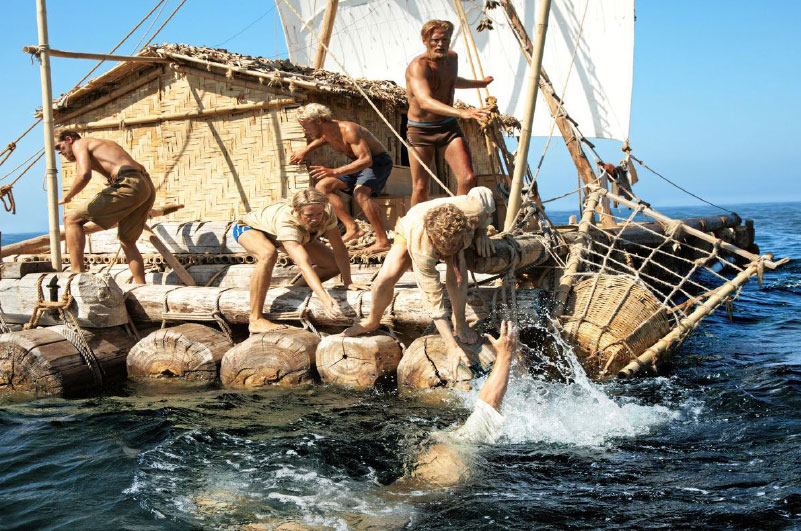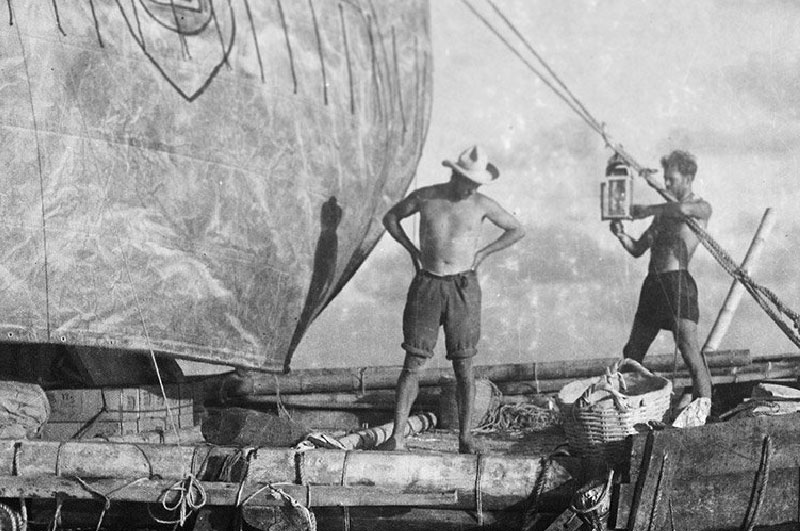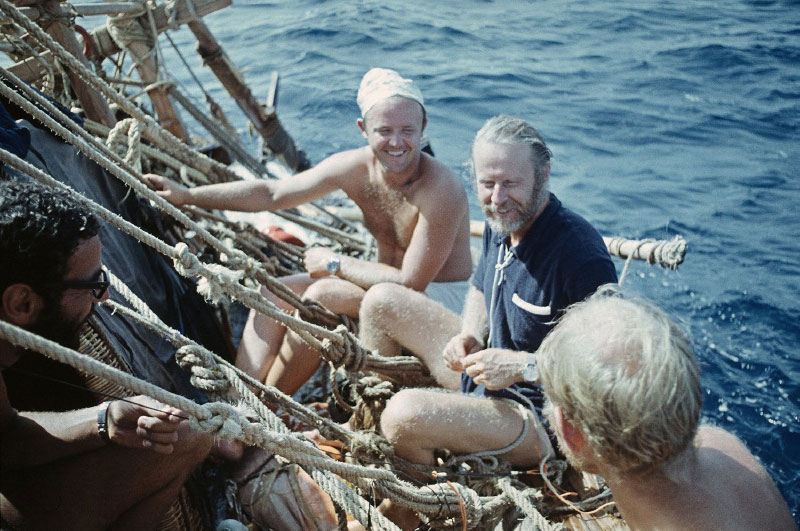


The sea adventures of a traveler-scientist
In 2019, we marked 50th anniversary of the Thor Heyerdahl journey, the great Norwegian scientist and navigator, in papyrus boat Ra. “Seven courageous” tool part in the expedition across the Atlantic Ocean. One of them was our fellow countryman — Yuri Senkevich, a doctor, journalist and traveler.
“It gives me pleasure to flick on the nose of dryasdusts scientists and haughty arrogant people,” said Thor Heyerdahl in an interview. A romantic, adventurer, a real scientist and a citizen of the world in the highest sense of the word, the Norwegian navigator became a legend during his lifetime. By the time the journey in Ra began, 55-year-old Heyerdahl was already famous throughout the world. He preferred to make discoveries not in the quiet of offices, but in the most remote corners of the earth. Back in 1937, he spent a year on the island of Fatu Hiva in Polynesia, studying the life and traditions of local tribes. Heyerdahl subsequently dedicated to this marvelous expedition the book “In Search of Paradise”, which became a bestseller in different countries of the world. During the Second World War, he wanted to fight against fascism, and the scientist became a soldier: in the USA he joined the army as a volunteer, in England he completed a diversionary radio school, and in 1944 he went to Murmansk as part of an American convoy. On the way, the convoy had been attacked; Soviet sailors saved the life of Heyerdahl and his friends. Thus the relations of the great traveler with our country began, that has remained uninterrupted for many years.
In 1947, Thor Heyerdahl and five of his associates built a primitive Kon-Tiki raft of balsa logs. The design was an exact replica of Inca rafts they used for long journeys. On the Kon-Tiki travelers planned to cross the Pacific Ocean from Peru in a westerly direction and prove that the ancestors of the Polynesians had come from South America. The raft was named Kon-Tiki after Polynesian legends hero. The expedition lasted for 101 days, Thor Heyerdahl and his friends managed to complete the plan. The “Kon-Tiki” book, written by the Norwegian traveler, was translated into 70 languages, its combined circulation amounted to over 50 million copies. The documentary that Heyerdahl and his friends made about their journey received the Oscar in 1952. Today in the capital of Norway, Oslo, there is the Kon-Tiki Museum, with the exhibits telling us about the life and adventures of the great seafarer.
In the years 1955–1956, Thor Heyerdahl organized a Norwegian archaeological expedition to Easter Island in the Pacific Ocean. The importance of the expedition can hardly be overestimated. Expedition included the study of the Moai monolithic stone statues, excavations at the Orongo and Poike, studies of flora and fauna, new versions of the appearance of man on this territory. Moai monolithic stone statues together with the entire Rapa Nui National Park now are UNESCO World Heritage sites. The “AKU-AKU: The Secret of Easter Island” book, written by Heyerdahl on the trip results, has become another world bestseller. It was during this expedition the Norwegian scientist discovered ancient drawings of reed boats with masts and sails. He wanted to prove that this kind of vessels could cross the Atlantic Ocean, the way it had been done, in his opinion, many centuries ago. So the idea arose, and it was subsequently implemented in travels in the “Ra” and “Ra-II.”
In the early 60s, Thor Heyerdahl met with Mstislav Keldysh, an outstanding Soviet scientist, one of the founders of astronautics, academician. This acquaintance of two great personalities subsequently was directly related to the Ra expedition. Its goal was to prove that the ancient Egyptians could cross the Atlantic Ocean on papyrus sailing vessels and, accordingly, the Indians of Peru and Mexico made their sea crossings the same way. Heyerdahl saw an obvious similarity between the architecture of Ancient Egypt and monuments of Mayan and Inca civilizations.
“The similarities between the early civilizations of Egypt and Mexico are not limited only to the pyramids… Both in Mexico and in Egypt there was a highly developed system of hieroglyphic writing… Scientists point to the similarity of fresco paintings in temples and tombs, similar construction of temples with skillful megalithic colonnades… They draw attention to the existence of huge stone human figures, to the amazing knowledge of astronomy and to highly developed calendar system in Mexico and Egypt… There are these and other numerous evidence of kinship of the cultures. Taken together, they could confirm the theory that ships from the shores of the Mediterranean Sea crossed the Atlantic Ocean once or repeatedly and brought the foundations of civilization to Mexico natives“ — wrote Thor Heyerdahl in his article “On The Trail Of The Sun-God.“
The boat for the future trip was built by craftsmen from Lake Chad of papyrus from the shores of Lake Tana in Ethiopia. It received its name in honor of the ancient Egyptian sun god Ra. When the question arose of selecting a crew, Thor Heyerdahl immediately decided that this time the team of seven would be international. The American Norman Baker became the navigator, the Italian cameraman — Carlo Mauri, the Mexican anthropologist — Santiago Henovesi, etc. In search of a ship’s doctor, the Norwegian navigator turned to his old acquaintance, Academician Keldysh. As Mstislav Keldysh later recalled, Heyerdahl put forward two requirements: the doctor should speak English and have a good sense of humor. So Yuri Senkevich became a team member in this legendary expedition. Earlier he had been involved with Keldysh in training of cosmonauts for flights. In 1969, Yuri Senkevich was 32 years old.
“There was no difference to Thor who was in front of him — a Russian, an American, an Arab, a Jew, a Papuan, a Black or a Chinese, as well as a communist, a capitalist, a Buddhist, a Christian, a Muslim or a pagan,” recalled Yuri Senkevich many years later.
Looking ahead, let’s say that the friendship of Heyerdahl and Senkevich would last for many years. Yuri Senkevich participated with the Norwegian scientist on Ra II expedition in 1970, sailed across the Indian Ocean on the Tigris in 1977–1978. But this time was still far away. It was still May 25 of 1969. The papyrus boat Ra was delivered to the port city of Larache in Morocco and was launched there. A journey full of dangers and adventures began, lasting for 56 days. On board, in addition to the crew members, there were Safi the Monkey, ducks and chickens. The tour, that Heyerdahl assembled, was somewhat similar to Noah’s Ark.
In the very first days of the voyage, it became obvious that mistakes had been made in the design of the vessel that would not allow completing the plan and crossing the Atlantic Ocean. The doctor Yuri Senkevich kept a diary. On June 4, 1969, he made the following entry, “In total, five oars broke and one was lost.” After 25 days, Yuri writes, “There is no doubt that we are going down more and more, albeit slowly. There is also no doubt that we will not sink, but the Ra will be flooded up to the deck for sure. ”Nevertheless, the crew of “Ra” did not give up until the end. When the ropes linking the papyrus began to break, the sailors sawed the polystyrene foam life raft and fixed it to the stern. This made it possible to hold out for another two weeks. Finally, it became clear that the expedition could not continue. Thor Heyerdahl and his team sent an SOS signal. “Three or four days passed, we were about to meet our rescuers. Rejoiced we threw everything overboard, including food and water, unaware that we wouldn’t see them for another five days. These five days were not the best in our life,“ wrote Yuri Senkevich. Only on July 16, 1969, the Ra team boarded the Shenandoah American yacht.
The international team managed to cover a distance of 5 thousand kilometers during this trip. The expedition was of great scientific and social importance. For example, Heyerdahl’s data on pollution of the oceans by oil clots presented in the UN report have contributed to the adoption of many measures aimed at protection of the environment, including the ban on draining oil waste into the open sea. General public in different countries with great interest read the book of Thor Heyerdahl “The Ra Expeditions” and watched a documentary film about this journey.
Еugenia Sineva
